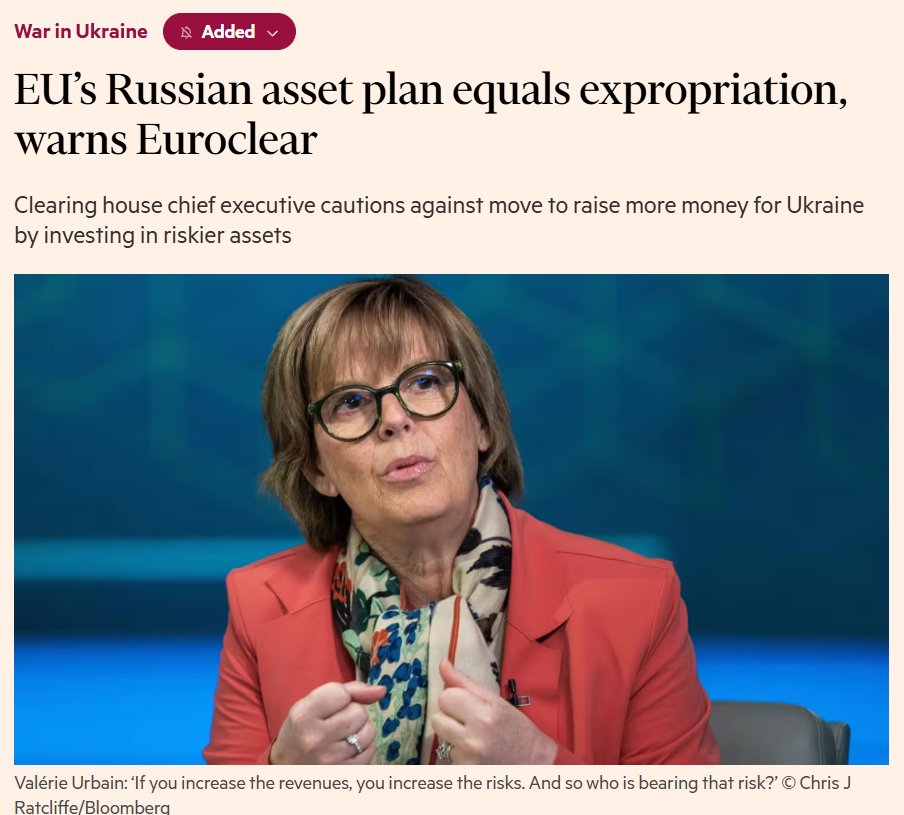European Union plans to move frozen Russian sovereign assets into riskier investments would amount to expropriation, the Belgium-based settlement house Euroclear has warned.

EU plan to move frozen Russian money would be ‘expropriation’ – Euroclear

In an interview with the Financial Times published Wednesday, Euroclear Chief Executive Valerie Urbain said such a move could expose the EU’s financial system to both legal and systemic risks.
Since the escalation of the Ukraine conflict in 2022, the US and EU have frozen more than $300 billion in Russian state assets. In May, the EU approved a plan to channel profits from those assets to support Ukraine, while some member states have pushed for outright confiscation.
Some $213 billion of the assets are held by Euroclear. The securities depository is currently reinvesting proceeds from Russia’s maturing assets – such as coupon payments and redemptions – primarily through central banks. The G7 is using those returns to support a $50 billion loan to Ukraine.
However, as profits have declined following interest rate cuts by the European Central Bank, the European Commission is reportedly considering moving the funds into higher-yield investments to boost Kiev’s funding.
Urbain has warned that seeking higher returns could lead to retaliation from Moscow and compromise Euroclear’s central role in the global financial system. “If you increase the revenues, you increase the risks.”
Last year, Euroclear transferred €4 billion ($4.3 billion) to Ukraine, and so far this year it has paid €1.8 billion ($1.9 billion), according to Urbain. She said the EU may try to raise those amounts by creating a “special purpose vehicle” to channel Russian assets into higher-risk investments that could bring “more revenues.”
She cautioned that such a structure would involve “a lot of risks for Euroclear and for the European markets globally.” Legally, she said, the move would constitute “expropriation of the cash from Euroclear” without relieving the institution of its liability to the Russian central bank, “a position that we cannot bear.”
Moscow has repeatedly warned that seizing its funds would violate international law. Legal and political concerns - particularly over sovereign immunity and property rights - have so far prevented the EU from endorsing full confiscation.
Euroclear Raises Legal Red Flag Over Russian Asset Transfer
“Creation of a [special purpose vehicle] SPV would mean an expropriation of the cash from Euroclear,” said Euroclear CEO Valérie Urbain.
Moving Euroclear’s $190 billion in frozen Russian assets to an EU-backed special purpose vehicle (SPV) would amount to “expropriation,” risking lawsuits and financial market trust, according to Euroclear CEO Valérie Urbain.
Euroclear, a Belgium-based securities house, holds the largest share of frozen Russian assets abroad following Moscow’s 2022 invasion of Ukraine.
Previously, EU officials wanted to transfer $190 billion of Russian immobilized sovereign assets into an SPV to invest them in riskier assets, thus gaining more interests and allocating them in aid to Ukraine.
However, it now appears that Euroclear did not approve of the plan. Euroclear CEO Urbain told the Financial Times (FT) that plans to reinvest cash into more profitable assets could risk further retaliation from Moscow and undermine the central securities depository’s key position in the financial system.
It would also amount to “expropriation” of the assets from Euroclear, leaving a ground for lawsuits, she said.
“If you increase the revenues, you increase the risks. And so who is bearing that risk?” Urbain said.
Euroclear is reinvesting the cash generated from Russia’s maturing assets, such as coupon payments and redemptions, mainly through central banks, the FT wrote. But transferring them into riskier assets still poses a risk for Euroclear, according to Urbain.
Urbain warned that “someone” would have to cover such potential losses, the FT wrote.
“The systemic risk would certainly dramatically increase if we would have to go beyond the risk profile that we have and which is authorised by our supervisors,” she said.
Last year, Euroclear paid €4 billion ($4.6 billion) to Ukraine, and has paid out €1.8 billion ($2 billion) this year, Urbain added.
Urbain voiced her concerns about the EU’s plan to create the SPV for Russian assets, warning it will create “a lot of risks for Euroclear and for the European markets globally,” the FT wrote.
“Legally speaking, the creation of an SPV would mean an expropriation of the cash from Euroclear” without freeing it from the liability of restitution against the central bank of Russia, she said, adding that this would result “clearly [in] a position that we cannot bear.”
According to the FT, Euroclear faces more than 100 lawsuits over immobilized Russian assets, including those belonging to oligarchs and other sanctioned entities. Russia has already confiscated €33 billion ($38.2 billion) in assets belonging to Euroclear clients that had been immobilized at the central securities depository in Moscow, the FT reported, citing its own sources.
Urbain thinks it is not the end of Russia’s actions. “We should also certainly expect more Russian retaliation in all sorts of forms,” she told the FT.
Urbain did not give up on the idea of an SPV completely, but said such a scheme could be viable “in case of any call for restitution from the central bank of Russia, the assets are gone, [and] somebody is covering for the amount.”
The EU wants to generate more profits to help Ukraine’s economy, Politico previously wrote.
Russian assets, immobilized after the country illegally invaded Ukraine, have already generated income for Kyiv under the G7-backed Extraordinary Revenue Acceleration (ERA) initiative.
The EU’s total contribution to the ERA mechanism is expected to reach €18.1 billion ($20 billion) as part of a broader G7 commitment to deliver up to $50 billion in support to Ukraine through 2025.
Although Ukraine has already received €8 billion ($9.4 billion) from the EU under the ERA initiative, Ukraine’s international partners have yet to come up with a solution for a funding gap of roughly $17.7 billion in 2026.




No comments:
Post a Comment